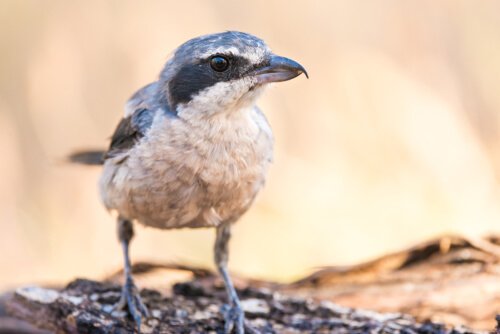Iberian Grey Shrike: The Butcher Bird

The Iberian grey shrike (Lanius meridionalis) is one of the most peculiar birds you can find. This bird’s behavior is quite unique, though often misunderstood.
What are shrikes? In the first place, all of them have similar characteristics. Despite being small birds with thin limbs, they all have beaks that make them look like raptors –it gives them a rapacious look.
It does make sense in a way, because the shrike is a small bird that hunts for insects and other small vertebrates. Even rodents, lizards and fellow birds can become their prey. Also, these birds are well-known for their executioner skills. Are you wondering how they do it? Read on and find out!
Characteristics of the Iberian grey shrike
The shrikes belong to the Laniidae family and they live in various parts of Africa, Asia, and Europe. There are species that reproduce in North America, although not so much in South America.
As their name indicates, the Iberian grey shrike is from the Iberian Peninsula. It’s a sedentary bird, common in dry areas and open environments such as those in the Canary Islands or along the Mediterranean continental slope.
Characteristics
This animal is very easy to recognize, and so if you’re into wildlife watching then this is a good one to check out if you travel to this area. Or, alternatively, you can look for the Great grey shrikes in North America, as they’re quite similar.
The Iberian grey shrikes are small, stout and have a long-tail. In addition, they’re easily identified by their beak and the black “mask” around their eyes.
The wings of these passerines are black and have a large white spot. Much of their body, however, is grayish in color, which makes them easy to identify. They’re only about 10 inches long, from the end of their tail to their beak, and their wingspan exceeds 12 inches when they’re fully open. Their birdsong is powerful and sort of metallic; it’s also quite varied as this animal is good at mimicking other birds.
Behavior
The most curious thing about the Iberian grey shrike is its behavior. These animals impale their prey on thorny plants and even on barbed wire, after catching them. Thanks to this, they can tear them apart by jerking them around, hence their nickname: the butcher bird.
Diet of the Iberian grey shrike
This species of bird usually stalks its prey from high places such as branches or even power lines. After this, as we mentioned above, the shrike impales its victims on sharp branches from sloes, hawthorns, and other thorny plants.
In regard to their reproduction, it begins in March in the area of the Iberian Peninsula, although it occurs earlier in Africa and the Canary Islands. These birds make their nests in thorny trees, where they lay up to seven specked white eggs whose nestlings hatch two weeks later.
It’s important to point out that, even though they’re not in danger of extinction, the Iberian grey shrike is considered “vulnerable” by the International Union for Conservation of Nature’s Red List of Threatened Species.
Habitat
There are several subspecies of Iberian grey shrike, which are fairly rare birds. In Europe, they mainly inhabit areas in southern France, Portugal, and Spain. Furthermore, the Canary Islands and North Africa are also part of their habitat, together with part of Asia.
This bird lives mainly in open areas. It’s often spotted perched on cables and other structures. They can also be found around scrubland, meadows, and crops such as almonds and olive groves.
As for their original Spanish habitat, they’re seldom seen in the Cantabrian watershed. There are a little over 500,000 specimens in southwestern Europe, although it seems they’re gradually disappearing.
